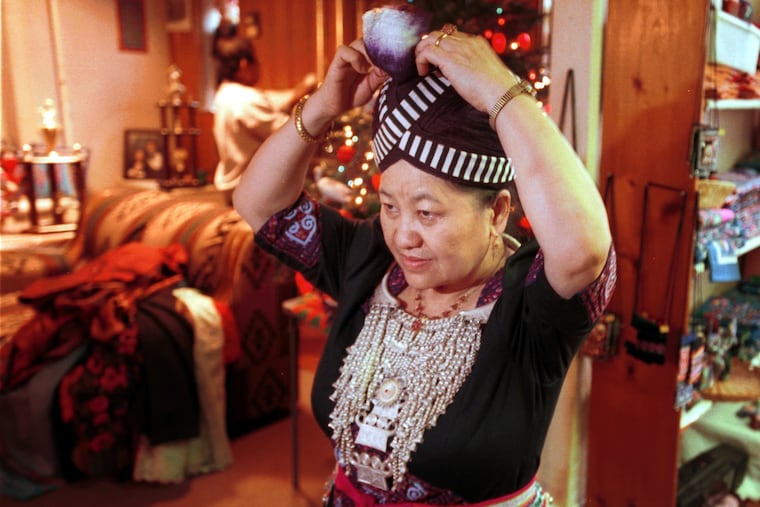Pang Xiong Sirirathasuk Sikoun, Philadelphia artist and keeper of Hmong culture, dies at 76
With needle and thread, she stitched her story into embroidered clothing and wallhangings: the communist takeover of Laos, years in a refugee camp, migration.

Pang Xiong Sirirathasuk Sikoun
76 years old
Lived in Upper Darby
She received awards from the National Endowment for the Arts
With needle and thread, she stitched her story into embroidered clothing and wallhangings: the communist takeover of Laos, years in a refugee camp, migration. And she spent a lifetime passing on the traditions of her genre, the Hmong textile art of paj ntaub, to others.
Pang Xiong Sirirathasuk Sikoun, 76, a Philadelphia artist and informal ambassador for Hmong culture locally, died Dec. 22 of COVID-19 at the Jeanes Campus of Temple University Hospital, her family said.
Pang, of Upper Darby, was recognized as a master of the embroidery technique paj ntaub (or flower cloth), pronounced pan dow. She exhibited at the Philadelphia Folklore Project and Wheaton Arts and Cultural Center, and twice in the 1980s was a participant in the Smithsonian Institution’s Festival of American Folklife. She received awards from the National Endowment for the Arts and Pennsylvania Council on the Arts and, in 1996, was a Pew Fellowship in the Arts winner.
For the artist, though, textiles were just one avenue of cultural expression.
“She was expert in an astonishing range of art forms, not only the needlework for which she is known, but also music and incredibly complex song traditions, and storytelling, customs and practices,” said Debora Kodish, the Philadelphia Folklore Project founder who worked with Pang for more than 30 years. “It was all integrated, all part of what being a Hmong person is. And the fact that she could keep this art relevant and present for multiple generations is so inspiring.”
Born in the mountains of northeast Laos’ Xiangkhouang province, the oldest of 14 children, she learned paj ntaub early on. At age 16, she married Charoon Sirirathasuk, a Thai paratrooper and medic in the Royal Lao Army, and they had six sons. After the Pathet Lao party assumed power, the family fled Laos, and from 1976 to 1979 they lived in the Ban Vinai Refugee Camp in Thailand. From there, in 1979, they immigrated to Philadelphia.
While studying English at the Community College of Philadelphia, Pang worked on her paj ntaub during class, and teachers asked to buy it, according to a biography provided by friends. One teacher helped to arrange for her to sell her work at Headhouse Square, and another suggested a Christmastime open house. That event became a local institution lasting for decades.
“You were walking into a museum of culture and history,” said Kodish of the annual open house. “She was a very good businesswoman, but that isn’t even the right word. She wanted to open people’s eyes and hearts, and she did. You never left without her giving you things. She brought everybody into this circle.”
She deployed her powerful brand of cultural diplomacy soon after arriving in Philadelphia, performing Hmong and Laotian dance at Drexel University and striking up a relationship with the Folklife Center of International House. She made it a mission to teach younger generations Hmong culture and paj ntaub.
“I need people to know my life,” she told The Inquirer in 1999. “Your life is like dreaming. I look at the pictures and I see my life is filled. I am passing on something good.”
In the 1980s, she and other members of the family began working at Friday Saturday Sunday, the restaurant near Rittenhouse Square, initially as dishwashers.
“Pang, who was always called Moma, and her husband, Pop, arrived to help,” as did their sons, said founder and former owner Weaver Lilley. “Although they were merely children, they helped out doing various chores and slowly moving up the ladder.”
But she and her family came to mean much more to the key player in Philadelphia’s restaurant renaissance.
“Pang was a person of limitless energy and optimism,” Lilley said. “Every problem had a solution. Possessing a great sense of humor, she easily navigated the stressful conditions of a kitchen under fire.”
Some dishes based on her culture’s cuisine, like the popular spiced beef salad, ended up on Friday Saturday Sunday’s menu. All six sons — Chakarin, Chakapope, Chakaphong, Chakawarn, Chakaphat, and Chakrith — have been active in the Philadelphia restaurant scene.
Though she was expert in her culinary traditions, dance, sung poetry, and art, Pang pursued “none of these things as art for art’s sake,” said Naomi Sturm-Wijesinghe, the Philadelphia Folklore Project’s executive director. “She was engaged in all of these things for the betterment of the community and her family.”
Her first husband died in 1994. In 1996 she married Somboun Sikoun, who survives her. In addition to her six sons, she is survived by six siblings: sister Mai Yia Xiong and brothers Nhia Toua Xiong, Wa Doua Xiong, Ka Moua Song, Chao Song, and Pa Chai Xiong; 29 grandchildren; and 10 great-grandchildren.
Services are planned (masked and socially distanced) for Saturday, Jan. 9, with a viewing and services starting at 10 a.m. at D’Anjolell Memorial Homes, 2811 W. Chester Pike in Broomall, and burial to follow at Philadelphia Memorial Park in Frazer. Details, and a way to support medical, funeral, and memorial costs, are at gofundme.com/f/honoring-pang-xiong-sirirathasuk.